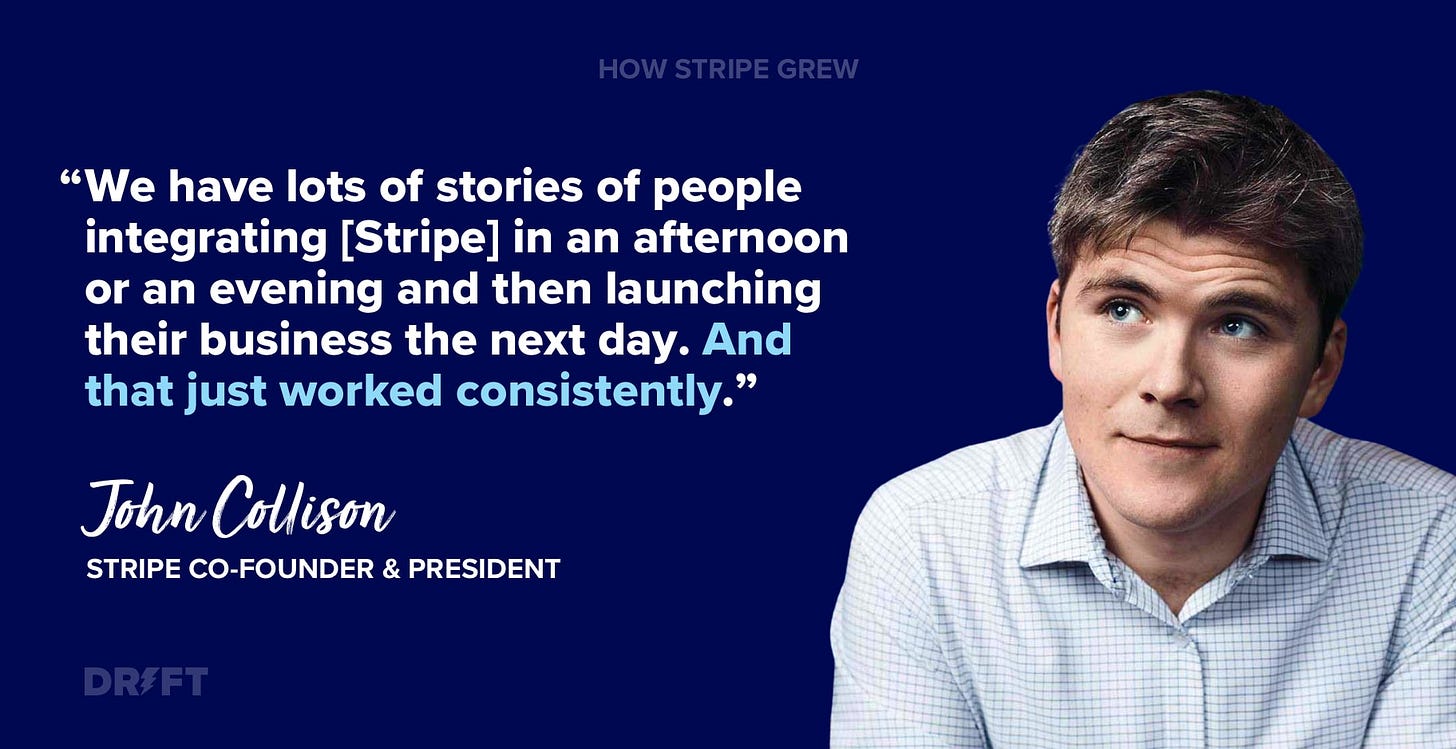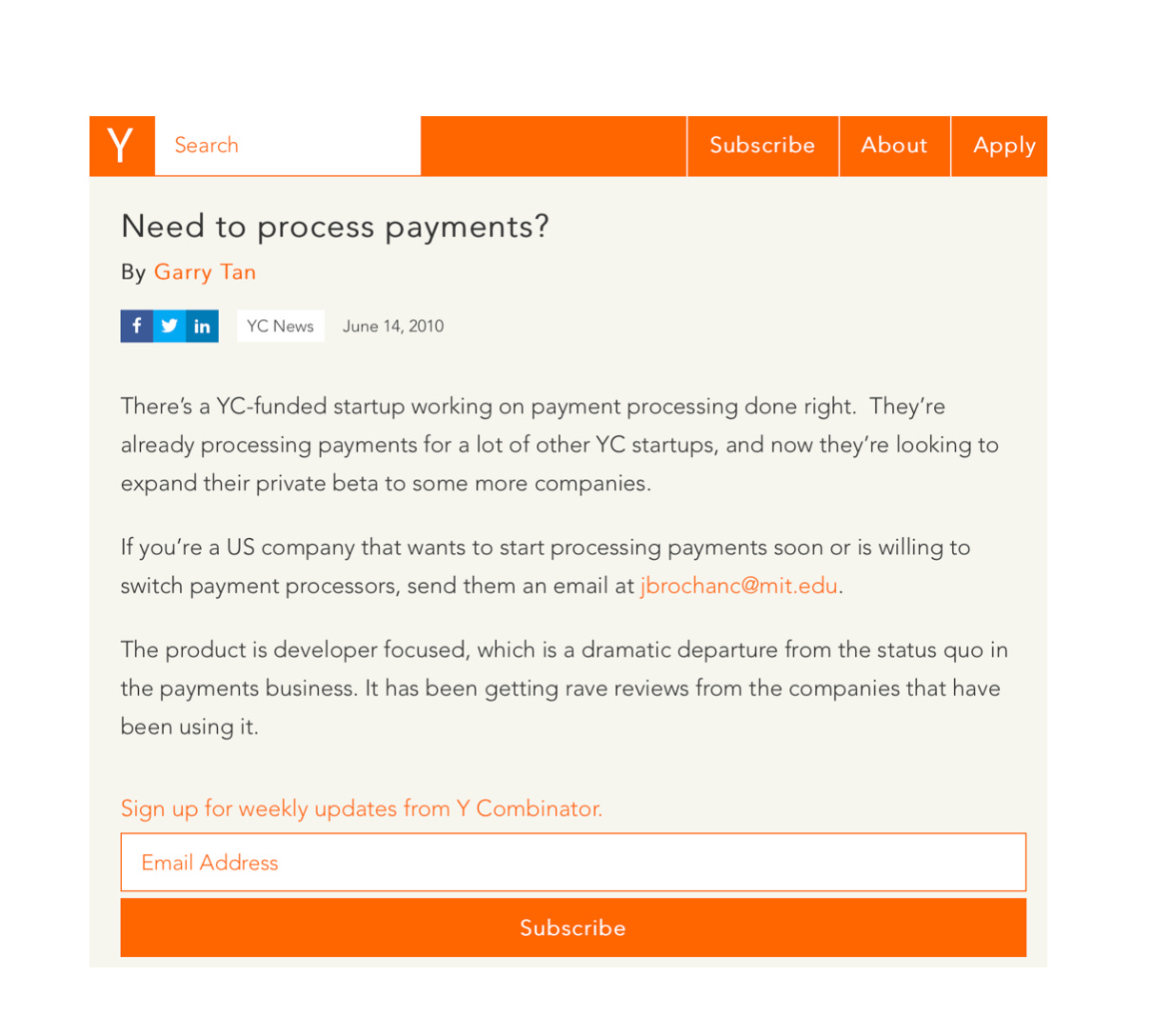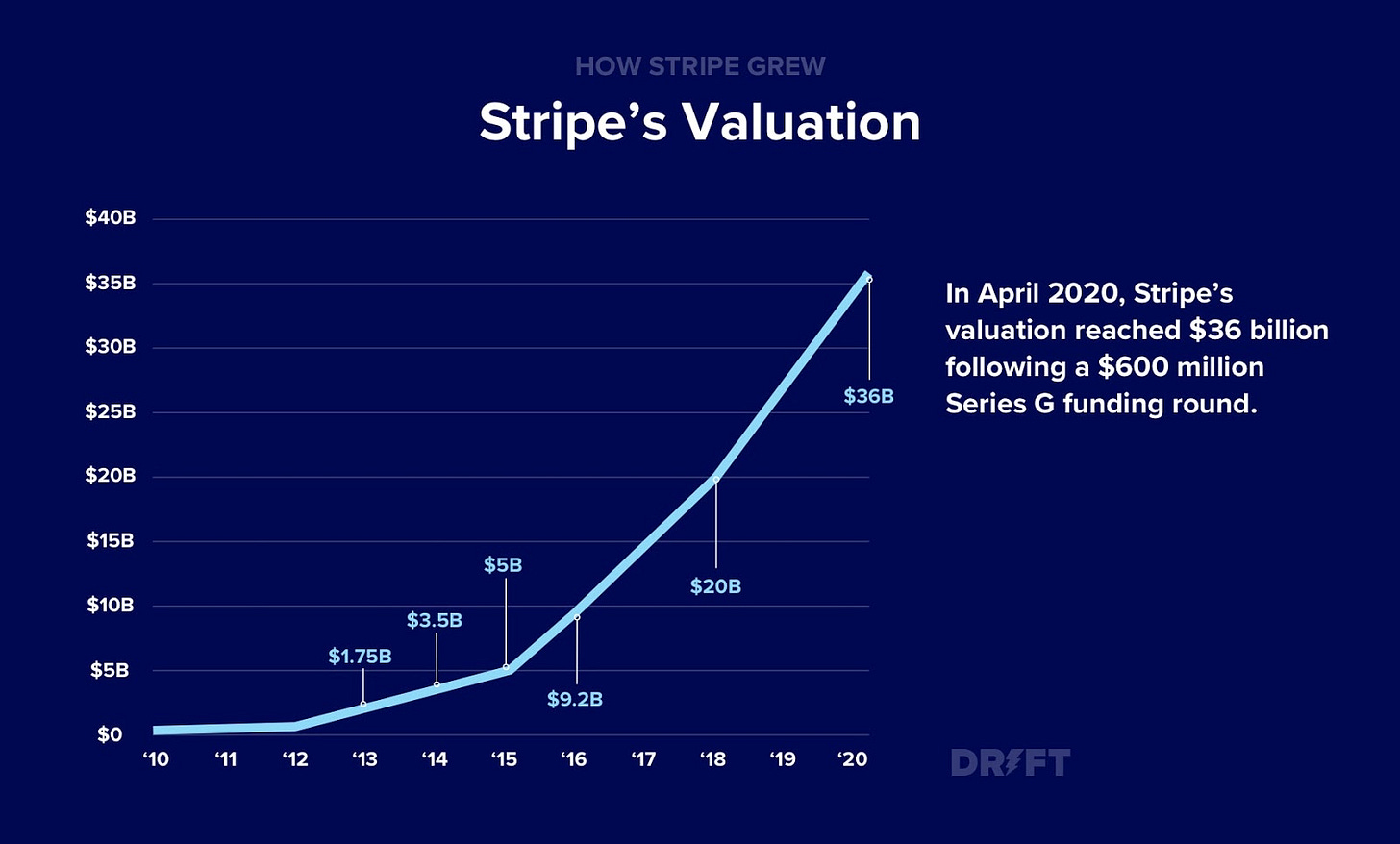How two brothers turned 7 lines of Code into a $115bn dollar company
Here are the most effective growth strategies behind Stripes impressive run
By 2010, it was becoming easier to build and launch online businesses, however one area that was still difficult (and outdated) was setting up the online payment process. At the time, legacy companies like Paypal were hard to work with on the business and development side. They had manual and outdated processes such as paper based applications, phone audits, and more.
Stripe’s founders Patrick and John Collison noticed the biggest problem was on the developer side. The current options were so limited for developers and the checkout experience lacked the intuitive experience they would like to offer. It was clear there was a need for a developer-friendly payment company. The brothers officially launched Stripe in september 2011 as a solution to this problem and their own frustrations.
The goal behind Stripe was simple—create a payments platform that “didn’t suck.”
Here's a big picture timeline
Strategy 1: Product led growth
Stripe started by solving a real and painful problem - a payment platform that “doesn’t suck” for a carefully defined group of people. A developer focused, instant setup payment platform with a few lines of code to integrate. Stripe did all the heavy lifting.
"Stripe originally built an incredibly simple and innovative approach to online payments,” said Eytan Bensoussan, who is the co-founder and CEO of NorthOne. It was the endo of financial service integrations that could take months or years.
Instead of shouting loudly, the Stripe team chose to focus on marketing through its products, the easy setup, the powerful API, and extensive documentation. They became by far the best option because they created a delightful experience for the end user while making it a delight to work with on the backend. They solved such a significant problem and did so with such a good customer experience, that the product sold itself so well. The product was such a game changer at the time, and developers couldn’t wait to use it
Their product sold itself so well that in 2011 they received $2M in seed funding from Paypal founder Peter Thiel and Elon Musk, sequoia capital, and others. They had over a 1000 person waitlist while still in beta at this time. By 2012 they were valued at $100M
Strategy 2: Smart Positioning
One of the smartest things Stripe did was position their product as a developer first product. It caught on because it didn’t sell to companies. Building a developer-first product made it really easy for companies and developers to accept payments immediately. It offered an alternative to paypal that was so much easier for developers to implement that developers around the word instantly started using it. It relieved such pain for developers that they couldn't help share their experiences with their friends.
It seemed clear, “that there should be a developer-focused, instant-setup payment platform that would scale to any size.” According to John Collison
Strategy 3: Word of mouth
Stipe initially benefited from the tight network of Y combinator. After meeting Paul Graham (Y Combinator founder) in 2007, the founders joined YC with a company called Auctomatic, only to be sold 10 months later. When they developed Stripe, they leveraged their YC network as their early adopters and beta testers, connecting with founders to integrate stripe.
Just like many amazing products, the majority of Stripe’s initial growth resulted from people who were excited to finally have an alternative payment method. After years of dealing with companies like Authorize.net and PayPal, developers were willing to try anything that helped them avoid the pain of another painful integration with either company.
This blog post was the catalysts of early traction (2010)
Their first 30 customers all came from YC. On their own, developers were sharing their positive experiences in blogs, on social media. Stripe acquired over 1000 customers on word of mouth alone, and only started paid advertising in 2012.
Word spread like wildfire, people couldn’t help but share their experiences. From word of mouth growth alone, they were valued at $1.75bn in 2012, joining the unicorn club. Multiple rounds of funding followed, increasing their valuation year over year
Strategy 4: Cult-Like Community
In 2012 They took advantage of this momentum by sending care packages to developers who deployed live instances of stripe. They included t-shirts, stickers + other swag fueling positive vibes for the brand. People proudly wore their t shirts in social media postings
They also facilitated developer meetups, hackathons and fun activities like capture the flag to build their community.The purpose was to raise awareness for the brand and create a community around the product. Their cult-like community of developers strengthened their referral network, creating a powerful word of mouth loop.
Their empowered community was a big reason why their organic growth was so effective.
Strategy 5: Multiple product launches
As the company gained users, the company gained a better understanding of what else their users wanted and needed. In 2012 Stripe started expanding it’s platform to more than just payments. they launched more products/integrations that fueled growth in acquisition, activation, and retention. Stripe connect launched in 2012, followed by stripe checkout in 2013, upgrading to one click payments in 2014. This followed by apply pay integration, enabling one touch payments on iOS apps, eliminating the need for any manual typing of credit card information.
Since launching more features and products, their valuation increased from 1.75Bn in 2012 to $9.2Bn in 2016.
Strategy 6: Expand customer base
In 2016, Stripe atlas was launched, a platform to help entrepreneurs start a business from anywhere in the world, incorporating them as a US company in delaware. It was an invite only platform that expanded their user base from the gaza strip to Cuba.
With this product, Stripe started targeting entrepreneurs from Africa, Latin America, the Middle East and parts of Asia. “A majority of the growth over the next ten years will come from underserved markets,” Jack explained. That's about 6.2 billion people they didn’t reach yet.
1Stripe Atlas helped them grow from a $9bn dollar valuation to $20bn in 2018. At its core was the ambition to “increase the GDP of the internet,” - stripes mission
Overall:
Stripes core growth initiatives have fallen under 3 main goals:
1. Broadly enable online commerce - online/offline payments, fraud prevention
2. Support merchant partner growth - stirpe connect, billing services, business lending
3. Grow the internet economy - stripe atlas
Stripe today:
Valued at $115bn (as of February 2021)
1.96 million active websites use stripe
Keys for success:
Solved a significant problem
Obsessed over customer experience
Cult like community
Had a vision for the future












